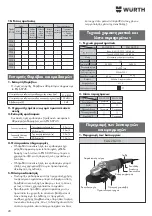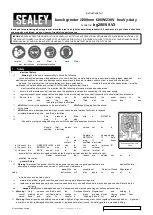
16
Such blades create frequent kickback and loss of
control.
3) Additional safety instructions for grinding
and cutting-off operations
Safety warnings specific for grinding and
abrasive cutting-off operations
a)
Use only wheel types that are recommended
for your power tool and the specific guard
designed for the selected wheel.
Wheels for which the power tool was not designed
cannot be adequately guarded and are unsafe.
b)
The guard must be securely attached to the
power tool and positioned for maximum
safety, so the least amount of wheel is
exposed towards the operator.
The guard helps to protect operator from broken wheel
fragments and accidental contact with wheel.
c)
Wheels must be used only for recommended
applications. For example: do not grind with
the side of cut-off wheel.
Abrasive cut-off wheels are intended for peripheral
grinding, side forces applied to these wheels may cause
them to shatter.
d)
Always use undamaged wheel flanges that
are of correct size and shape for your
selected wheel.
Proper wheel flanges support the wheel thus reducing
the possibility of wheel breakage. Flanges for cut-off
wheels may be different from grinding wheel flanges.
e)
Do not use worn down wheels from larger
power tools.
Wheel intended for larger power tool is not suitable for
the higher speed of a smaller tool and may burst.
4) Additional safety instructions for cutting-off
operations
Additional safety warnings specific for
abrasive cutting-off operations
a)
Do not "jam" the cut-off wheel or apply
excessive pressure. Do not attempt to make
an excessive depth of cut.
Overstressing the wheel increases the loading and
susceptibility to twisting or binding of the wheel in the
cut and the possibility of kickback or wheel breakage.
b)
Do not position your body in line with and
behind the rotating wheel.
When the wheel, at the point of operation, is moving
away from your body, the possible kickback may propel
the spinning wheel and the power tool directly at you.
c)
When wheel is binding or when interrupting
a cut for any reason, switch off the power
tool and hold the power tool motionless until
the wheel comes to a complete stop. Never
attempt to remove the cut-off wheel from the
cut while the wheel is in motion otherwise
kickback may occur.
Investigate and take corrective action to eliminate the
cause of wheel binding.
d)
Do not restart the cutting operation in the
workpiece. Let the wheel reach full speed
and carefully reenter the cut.
The wheel may bind, walk up or kickback if the power
tool is restarted in the workpiece.
e)
Support panels or any oversized workpiece
to minimize the risk of wheel pinching and
kickback.
Large workpieces tend to sag under their own weight.
Supports must be placed under the workpiece near the
line of cut and near the edge of the workpiece on both
sides of the wheel.
f)
Use extra caution when making a "pocket
cut" into existing walls or other blind areas.
The protruding wheel may cut gas or water pipes,
electrical wiring or objects that can cause kickback.
5) Additional safety instructions for sanding
operations
Safety warning specific for sanding
operations
a)
Do not use excessively oversized sanding disc
paper. Follow manufacturers
recommendations, when selecting sanding
paper.
Larger sanding paper extending beyond the sanding
pad presents a laceration hazard and may cause
snagging, tearing of the disc or kickback.
6) Additional safety instructions for polishing
operations
Safety warning specific for polishing
operations
a)
Do not allow any loose portion of the
polishing bonnet or its attachment strings to
spin freely. Tuck away or trim any loose
attachment strings.
Loose and spinning attachment strings can entangle
your fingers or snag on the workpiece.
7) Additional safety instructions for wire
brushing operations
Safety warnings specific for wire brushing
operations
a)
Be aware that wire bristles are thrown by
the brush even during ordinary operation.
Do not overstress the wires by applying
excessive load to the brush.
The wire bristles can easily penetrate light clothing
and/or skin.
b)
If the use of a guard is recommended for
wire brushing, do not allow any interference
of the wire wheel or brush with the guard.
Wire wheel or brush may expand in diameter due to
work load and centrifugal forces.
Содержание EAG 20-230
Страница 2: ...2 DE 3 12 GB 13 21 GR 22 32 HR 33 41 BiH 33 41 RS 42 50 ME 42 50 bg 51 62 Ro 63 72 SI 73 83 AL 84 92 ...
Страница 93: ...93 ...
Страница 94: ...94 ...
Страница 95: ...95 ...
















































